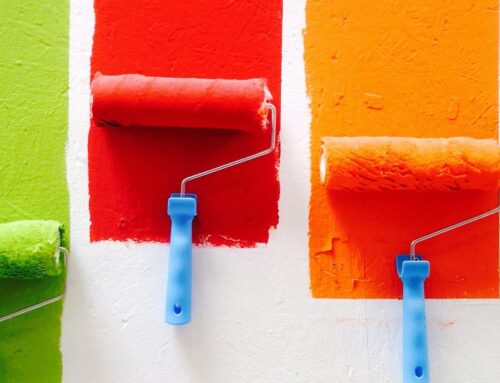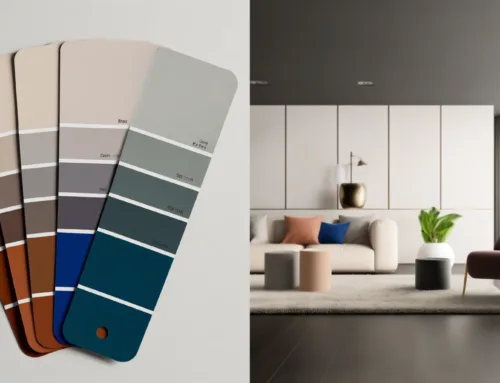
Selecting the Perfect Paint: A Guide to Choosing Wisely
Choosing the right paint for your project is crucial in achieving the desired look and feel of your space. Whether you are painting a room in your home or a commercial space, the color and quality of the paint can greatly impact the overall aesthetic. The right paint can enhance the ambiance, create a specific mood, and even make a small space appear larger. With so many options available, it is important to understand the different types of paint, consider factors such as surface type and lighting, and choose a high-quality product for a perfect finish.
Key Takeaways
- Understanding the different types of paint is crucial in choosing the perfect paint for your project.
- Color selection plays a significant role in achieving the desired look and feel of your space.
- Before choosing a paint, consider factors such as the surface type, location, and lighting.
- High-quality paint is essential for achieving a perfect finish that lasts longer.
- Champion Painting offers numerous benefits, including professional expertise and high-quality materials.
Understanding the Different Types of Paint
There are several types of paint available on the market, each with its own unique properties and benefits. The most common types of paint include latex, oil-based, and acrylic. Latex paint is water-based and dries quickly, making it easy to clean up with soap and water. It is also more resistant to cracking and fading over time. Oil-based paint, on the other hand, provides a smoother finish and is more durable, making it ideal for high-traffic areas. Acrylic paint is a versatile option that combines the benefits of both latex and oil-based paints.
Each type of paint has its pros and cons. Latex paint is easy to work with and has low levels of volatile organic compounds (VOCs), making it a more environmentally friendly option. However, it may not be as durable as oil-based paint and may require more coats for full coverage. Oil-based paint provides a smoother finish and is more resistant to stains and moisture, but it has a strong odor and takes longer to dry. Acrylic paint offers good coverage, durability, and easy cleanup, but it may not adhere well to certain surfaces.
The Importance of Color Selection
Color plays a significant role in creating the mood and atmosphere of a room. It can evoke emotions, influence behavior, and even affect our perception of space. When choosing a color for your space, it is important to consider the purpose of the room and the desired ambiance. For example, warm colors like red, orange, and yellow can create a cozy and inviting atmosphere, while cool colors like blue and green can promote a sense of calm and relaxation.
In addition to the psychological effects, color can also impact the visual perception of a room. Lighter colors tend to make a space appear larger and more open, while darker colors can make a room feel smaller and more intimate. It is also important to consider the existing decor and furnishings in the space when choosing a color. A cohesive color scheme can tie the room together and create a harmonious look.
Factors to Consider Before Choosing a Paint
| Factors to Consider Before Choosing a Paint | Description |
|---|---|
| Surface Type | Different surfaces require different types of paint. For example, wood surfaces require a different type of paint than metal surfaces. |
| Paint Finish | The finish of the paint can affect the overall look of the room. Choose from matte, eggshell, satin, semi-gloss, or high-gloss finishes. |
| Color | Choose a color that complements the room’s decor and creates the desired mood. Keep in mind that darker colors can make a room feel smaller. |
| Quality | Higher quality paints tend to have better coverage, durability, and color retention. They may also be more expensive. |
| Environmental Impact | Consider using eco-friendly paints that have low VOC (volatile organic compound) levels to reduce the impact on the environment and improve indoor air quality. |
| Application Method | Choose a paint that is suitable for the application method you plan to use, such as brush, roller, or spray. |
Before choosing a paint, there are several factors to consider to ensure the best results. One important factor is the surface type and condition. Different surfaces require different types of paint and preparation. For example, if you are painting a wall with existing paint, you may need to sand it down or apply a primer before applying a new coat of paint. If you are painting a surface that is prone to moisture or high humidity, such as a bathroom or kitchen, you may need to choose a paint that is specifically designed for these conditions.
Another factor to consider is the lighting in the room. Natural light and artificial light can greatly affect how colors appear. It is important to test paint samples in different lighting conditions to see how they look before making a final decision. Additionally, consider the direction of the light source and how it will interact with the paint color. For example, north-facing rooms tend to have cooler light, so warm colors may appear duller in these spaces.
Budget and timeline are also important factors to consider. High-quality paint may be more expensive upfront but can save you money in the long run by lasting longer and requiring fewer coats. It is also important to consider the time it will take to complete the project. Some paints may require multiple coats or longer drying times, which can extend the timeline of your project.
The Role of Paint Quality in Achieving a Perfect Finish
The quality of the paint you choose can greatly impact the final result of your project. High-quality paint not only provides better coverage and durability but also offers a more vibrant and long-lasting finish. It is worth investing in a reputable brand that uses high-quality ingredients and has a proven track record.
High-quality paint is formulated with better pigments, binders, and additives, resulting in better color retention, resistance to fading, and improved coverage. It also tends to have lower levels of VOCs, making it safer for both the environment and your health. Additionally, high-quality paint is easier to apply and provides a smoother finish, reducing the need for touch-ups or additional coats.
The Benefits of Choosing Champion Painting

When it comes to choosing the perfect paint for your project, Champion Painting is a trusted name in the industry. With years of experience and a team of skilled professionals, they offer a wide range of painting services tailored to meet your specific needs.
Champion Painting understands the importance of choosing the right paint and can help guide you through the selection process. Their team of experts can provide advice on color selection, paint type, and finish to ensure that you achieve the desired look and feel for your space. They work closely with clients to understand their vision and deliver exceptional results.
In addition to their expertise, Champion Painting uses only high-quality paints from reputable brands. They understand that quality matters and are committed to providing their clients with long-lasting and beautiful finishes. By choosing Champion Painting, you can have peace of mind knowing that your project is in capable hands.
How to Choose the Right Paint Finish
Choosing the right paint finish is just as important as choosing the right color and type of paint. The finish can greatly impact the overall look and feel of a room. There are several different paint finishes to choose from, including matte, satin, eggshell, semi-gloss, and gloss.
Matte finishes have a flat appearance and are ideal for hiding imperfections on walls. They provide a smooth and velvety finish but are not as durable or washable as other finishes. Satin finishes have a slight sheen and are more durable and washable than matte finishes. They are a popular choice for high-traffic areas such as hallways and kitchens.
Eggshell finishes have a low sheen and offer a subtle glow to the walls. They are more washable than matte finishes but may not be as durable as satin finishes. Semi-gloss finishes have a higher sheen and are highly durable and washable. They are commonly used in bathrooms, kitchens, and trim work. Gloss finishes have the highest sheen and provide a shiny and reflective surface. They are extremely durable and washable but may show imperfections more easily.
When choosing a paint finish, consider the purpose of the room and the level of durability and washability required. It is also important to consider the existing decor and furnishings in the space to ensure a cohesive look.
Tips for Preparing Your Surface Before Painting

Proper surface preparation is essential for achieving a professional-looking paint job. Before painting, it is important to clean the surface to remove any dirt, dust, or grease that may affect the adhesion of the paint. Use a mild detergent or TSP (trisodium phosphate) solution to clean the surface thoroughly.
If you are painting over an existing painted surface, it may be necessary to sand it down to create a smooth and even surface. This will help the new paint adhere better and provide a more professional finish. Use sandpaper or a sanding block to gently sand the surface, being careful not to apply too much pressure or damage the underlying material.
In some cases, it may be necessary to apply a primer before painting. Primers help to seal the surface, improve adhesion, and provide a uniform base for the paint. They are especially important when painting over porous surfaces or when making a drastic color change. Choose a primer that is compatible with the type of paint you are using and follow the manufacturer’s instructions for application.
The Best Tools and Techniques for Applying Paint
Choosing the right tools and using the proper techniques can make a significant difference in the final result of your paint job. The most common painting tools include brushes, rollers, and sprayers.
Brushes are ideal for cutting in and painting smaller areas such as trim, corners, and edges. Choose a brush with high-quality bristles that are suitable for the type of paint you are using. Synthetic bristles are best for latex paints, while natural bristles are better suited for oil-based paints. Use long, smooth strokes and avoid applying too much pressure to prevent brush marks.
Rollers are great for covering large areas quickly and efficiently. Choose a roller cover with the appropriate nap length for your surface. Shorter nap lengths are best for smooth surfaces, while longer nap lengths are better for textured surfaces. Use a roller tray to evenly distribute the paint on the roller cover and apply it in a “W” or “M” pattern to ensure even coverage.
Sprayers can be used for larger projects or when a smooth and flawless finish is desired. They provide an even application of paint but require more skill and practice to use effectively. Follow the manufacturer’s instructions for setup and application to achieve the best results.
Maintaining Your Painted Surfaces for Long-Lasting Results
Once your project is complete, it is important to properly maintain your painted surfaces to ensure long-lasting results. Regular cleaning and maintenance can help extend the life of your paint job and keep it looking fresh and vibrant.
To clean painted surfaces, use a mild detergent or soap and water solution. Avoid using harsh chemicals or abrasive cleaners, as they can damage the paint. Use a soft cloth or sponge to gently clean the surface, being careful not to scrub too hard or remove the paint.
 In high-traffic areas or areas prone to moisture, such as bathrooms and kitchens, consider applying a clear topcoat or sealer to protect the paint from wear and tear. This will provide an extra layer of protection and make it easier to clean.
In high-traffic areas or areas prone to moisture, such as bathrooms and kitchens, consider applying a clear topcoat or sealer to protect the paint from wear and tear. This will provide an extra layer of protection and make it easier to clean.
It is also important to address any issues or damage to the painted surfaces as soon as possible. Touch up any chips or scratches with matching paint to prevent further damage and maintain the overall appearance of the space.
Choosing the perfect paint for your project is essential in achieving the desired look and feel of your space. Understanding the different types of paint, considering factors such as surface type and lighting, and investing in high-quality products are all important steps in achieving a perfect finish.
Champion Painting offers a wide range of services and expertise to help you choose the right paint for your project. By following proper surface preparation techniques, using the right tools and techniques for application, and maintaining your painted surfaces, you can enjoy long-lasting and beautiful results. So, take the time to choose the perfect paint for your next project and transform your space into something truly remarkable.
If you’re looking for more tips on home improvement projects, you might find our article on staining your decking helpful. It provides valuable insights and step-by-step instructions to help you achieve a beautifully stained deck. Whether you’re a DIY enthusiast or hiring a professional, this article will guide you through the process. Check it out here.
Interior Painting | Exterior Painting | Commercial Painting | Handyman Services
FAQs- Perfect Paint

What are the different types of paint?
There are several types of paint, including latex, oil-based, enamel, acrylic, and watercolor. Each type has its own unique properties and is suitable for different surfaces and applications.
What is latex paint?
Latex paint is a water-based paint that is easy to clean up with soap and water. It dries quickly and is suitable for use on walls, ceilings, and other interior surfaces.
What is oil-based paint?
Oil-based paint is a type of paint that uses oil as its base. It is durable and provides a smooth, glossy finish. It is suitable for use on wood, metal, and other surfaces that require a tough, long-lasting finish.
What is enamel paint?
Enamel paint is a type of paint that dries to a hard, glossy finish. It is suitable for use on metal, wood, and other surfaces that require a durable, long-lasting finish.
What is acrylic paint?
Acrylic paint is a water-based paint that dries quickly and is suitable for use on a variety of surfaces, including canvas, paper, and wood. It is known for its vibrant colors and versatility.
What is watercolor paint?
Watercolor paint is a type of paint that is transparent and is used to create delicate, subtle effects. It is suitable for use on paper and other porous surfaces.
How do I choose the right type of paint?
To choose the right type of paint, consider the surface you will be painting, the desired finish, and the application method. You should also consider factors such as durability, ease of use, and environmental impact. Consult with a paint expert or read product labels for more information.
Page design by Website Design and Marketing Near Me

Champion Painting
Recent Post's
Champion Painting is a professional painting contractor that provides high-quality painting services for residential and commercial spaces. With years of experience in the industry, Champion
Painting Safety Precautions to Keep You Protected When it comes to any painting project, safety should always be a top priority. Painting may seem like
Champion Painting: Home Painter in Oceano Champion Painting is a reputable house painting company that offers its services in Oceano. With years of experience in
Home | Green Painting: Eco-Friendly Painting Options Green painting is a term used to describe the use of eco-friendly paints and materials in the process
Get a Free Estimate
















